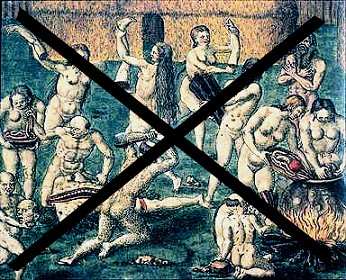
Confident to have under observation the remains of a sacrificial ceremony, Vlassa jumped to the unproven conclusion that a cannibalistic ritual had taken place. The below painting of Theodor de Bry "Cannibal Scene from Grandes Voyages Pt. III" (1593) addresses this subject directly. This hypotheses was based on a week circumstantial evidence but not weird because there is documentation on a few cannibalistic ceremonies in order to communicate with gods and spirits in the Danube civilization.  But at Tărtăria did not happened any kind of ritual cannibalism. Firstly, in the case of both ritual and secular cannibalism it is possible to find some selected remains (in particular from head, arms, legs). In the excavation at Skantea (Moldavia, Romania) some remains of the skullcap and of the arms have been found by Magda Lazarovici. [23] In Iclod (Cluj county, Romania) a buried beheaded man held a portion of his skullcap on his hand. And so on. Regarding Tărtăria bones, we have found too wide a range of them and many are useless as food (i.e. ribs, basin and vertebras). Moreover we didn't find any skull fragments. Secondly, in a banquet the bones are scattered on the ground among the remains of meals, sometimes refuse in domestic waste zones or crushed by dogs. In Tărtăria they were packed and accompanied by ritual and high status artefacts. Thirdly, the bones were broken in a natural way and not, for example, crushed to extract the marrow as at Orăstie (Hunedoara county, Romania). Last but absolutely not list, the bones are not burnt. Not at all. | |
Merlini Tărtăria | 1 | 2 | 3 | 4 | 5 | 6 | 7 | 8 | 9 | 10 | 11 | 12 | 13 | 14 | 15 | |